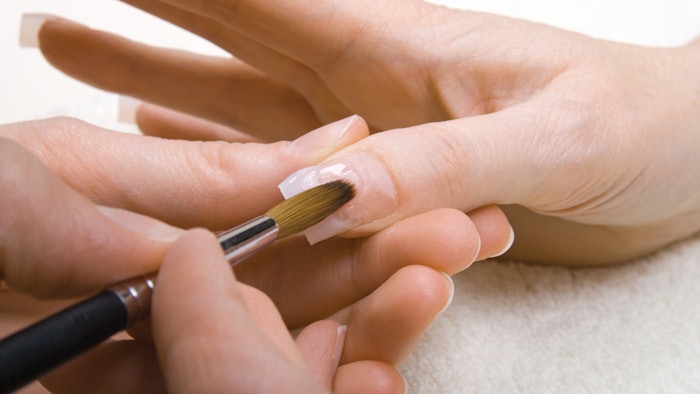
By Ami McClure & Traci Dungan
Working with acrylic is an art. It’s very common for techs coming out of school to think that it will be easy—and they’re quickly surprised to discover how challenging it is to master. The only way to really grasp it is through practice. With so many kinds of products, nail types and imperfections, the whole experience can feel overwhelming. Before you give up, remember to give yourself time to practice and experiment until you find what works for you. Here, we offer some practical tips and tricks for working with acrylic to help you get started.
Choosing the Right Brush
Brushes can get pricey, so do your research first. We only use brushes that are 100-percent kolinsky. There are cheaper synthetic brushes out there, but it’s best to stay away from them for acrylic application. Synthetic hairs will stick to your acrylic like bubblegum. You can also find kolinsky and synthetic blends (or even blends with different, less expensive types of hair), but again, we prefer 100-percent kolinsky. While these brushes are more expensive, they will last 100 times longer than any mix and1,000 times longer than a synthetic brush.
When it comes to the size of the brush, bigger is not better. There’s a trend right now of using enormous brushes when applying acrylic. When we see that, we see a ton of product waste, flooded cuticles and overexposure. Brushes are formed with a well in the middle of them that holds the liquid. The bigger the brush, the more liquid you pick up. Even if you wipe out most of the liquid, you’ll notice that your monomer will become cloudy and contaminated by the end of the service, and you’ll have to dispose of it, so it’s fairly wasteful—and we all know liquid is one of the priciest products in the service! In addition, if there’s too much liquid in the brush and you’re working too wet, when you press to release the pearl of acrylic onto the nail, all of the liquid will release and run onto the nail and around the cuticle area, causing overexposure.
That being said, we will choose a larger brush (#10) when sculpting, because we want to pick up a lot of product. But when doing a thin overlay or fill, we’ll use a smaller #6 or #8 brush, as it allows you to pick up just the amount of product you need so you can control it with little waste.
Finally, don’t forget to clean your brush. If you get acrylic in it, simply clean it with monomer only. Yes, acetone will soak acrylic out as well, but it will also dry out your brush, and it will never be the same. A lot of brush cleaners will mix monomer and acetone, so make sure to read the ingredients before using. While monomer can take a bit longer to remove the acrylic, it will eventually break it down and your brush will be as good as new. Always check your brush at the end of the day or periodically between clients to make sure that there isn’t anything trapped in there. Removing already-cured acrylic is sometimes impossible.
Stress Area and Arch Placement
The stress area is where the free edge of the natural nail meets the acrylic, and it’s going to be different on every nail. Because this area is where the nail takes on the most pressure, it’s where the bulk of your product needs to be. The arch location, on the other hand, is all about overall beauty. You may prefer an arch closer to the cuticle, as it seems to lengthen the nail, almost slenderizing it a bit. Or you may prefer to go closer to the center, which is a more classic look. However, if you go too low, it will cause the nails to appear off-balance, so we like to keep the arch a bit higher than the stress area.
With all of the added product to maintain the stress area and arch, it’s easy for the enhancement to become too thick. Remember: Thicker is not better! Nails don’t handle bulky acrylic application well and will usually lift. The nail should be the same thickness at the cuticle and free edge, with the stress area being the thickest. A good rule of thumb is to keep the cuticle and free edge the thickness of a credit card.
Troubleshooting Tips
Working with acrylic can be tricky, and when there’s product or service breakdown, we’re often left wondering why.
For the full article, please visit Nailpro's January/February digital magazine.
NAILPRO advisory board members Ami McClure and Traci Dungan are sisters, nail techs, partners and owners of ProFiles Backstage based in Florida.











